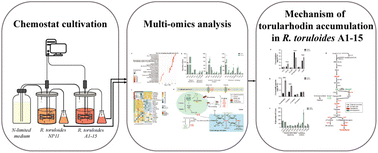Multi-omics analysis reveals the mechanism of torularhodin accumulation in the mutant Rhodosporidium toruloides A1-15 under nitrogen-limited conditions†
Abstract
A carotenoid production strain Rhodosporidium toruloides NP11 and its mutant strain R. toruloides A1-15 were studied under chemostat nitrogen-limited cultivation. Multi-omics analysis (metabolomics, lipidomics and transcriptomics) was used to investigate the different mechanisms of torularhodin accumulation between NP11 and A1-15. The results showed that the carotenoid synthesis pathway was significantly enhanced in A1-15 compared to NP11 under nitrogen limitation, due to the significant increase of torularhodin. Under nitrogen-limited conditions, higher levels of β-oxidation were present in A1-15 compared to those in NP11, which provided sufficient precursors for carotenoid synthesis. In addition, ROS stress accelerated the intracellular transport of iron ions, promoted the expression of CRTI and CRTY genes, and reduced the transcript levels of FNTB1 and FNTB2 in the bypass pathway, and these factors may be responsible for the regulation of high torularhodin production in A1-15. This study provided insights into the selective production of torularhodin.



 Please wait while we load your content...
Please wait while we load your content...